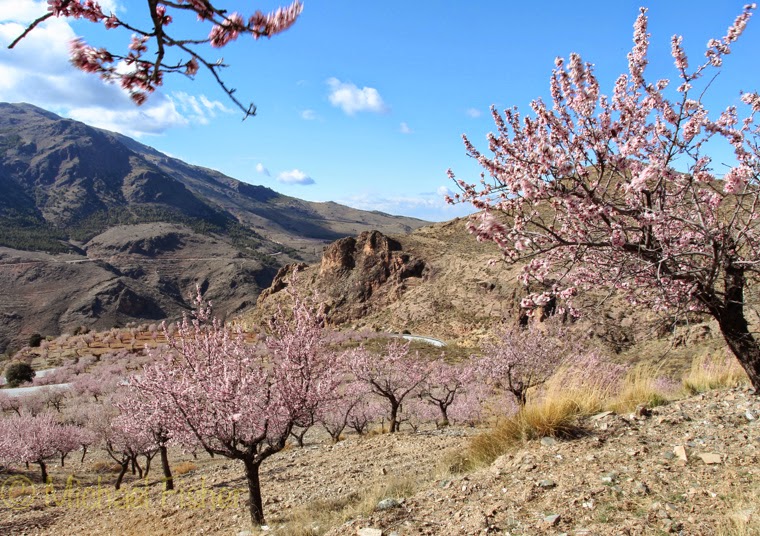While we were in the area of Almeria, one of the things we most wanted to see
was the Iberian Ibex, the Spanish wild goat. This hardy creature lives high in these Sierras,
but so far it had eluded us, so we set off into the Sierra de los Filabres, hoping for a glimpse of these
elusive creatures, climbing higher and higher, through wild and stunning scenery.
was the Iberian Ibex, the Spanish wild goat. This hardy creature lives high in these Sierras,
but so far it had eluded us, so we set off into the Sierra de los Filabres, hoping for a glimpse of these
elusive creatures, climbing higher and higher, through wild and stunning scenery.
And we were in luck, as we drove a deserted small road, we spotted, ahead of us
a small group of Ibex.
They had also spotted us, so Mike set off to stalk them, camera at the ready.
He managed to get closer.
The males are quite magnificent, with a huge pair of horns, sadly making them most attractive
to trophy hunters, as they are still allowed, under license and hugely restricted, to hunt them.
What a magnificent chap, he has nothing to fear from us, except a photograph.
Then they were away, leaping above us to higher pasture and all was quiet again on the mountain,
you would never know they had passed this way, but we had seen them
and will never forget.
We stopped and looked back from the height of 2080 mtrs and what a sight it was,
although the temperature was now only 1*
Descending we passed through Almond trees, full blown with blossom towards Bacares.
Our journey continued into the Park Natural St Barbara, passing some old ruined farmsteads
shadows of a bygone age.
Now in the Sierra Baza, as we climb higher, the weather has changed,
and the temperature drops to minus 1*
it is a bit of a shock to see the trees covered in snow.
We cannot believe how quickly the weather changes here, one minute it is grey and stormy
then blue sky and sunshine, but it is still so cold!
There is a storm roaring in, it gets very dark and great clouds build up before our eyes.
We watch in awe as a blizzard hits us with it's full force.
And then it is gone, again we can see the incredible view of a patchwork of landscape below us.

We descended and at this point went onto a dirt track for 40 kms.
Along this track we discovered an old deserted village called EL Tesorero ( we think)
as there are many deserted villages here and nothing shows on our map!
Everyone has left, all farming gone and the mines have shut down.
This area was like Spains gold rush and is now a beautiful natural park.
After 40 kms of dirt track we found our way out.
On our way back and now in a temperature of 20* Mike photographed this beautiful Short Toed Eagle.
It is the snake eater, common in our area of France and has just made its crossing from Africa. Sometimes you can see it high in the air with a snake wriggling in it's talons.
Other migrators northward are these beautiful Bee-eaters, Mike caught with his camera,
feasting on Bees among the Almond blossom.
What a wonderful day, Iberian Ibex, snow storms, Eagle and Bee-eaters.
We have now left the region of Almeria after exploring beyond the plastic poly tunnels
that proliferate this area of Spain and if you look beyond the intense farming practices here,
you will find a wonderful diversity of nature and landscapes. Our journey continues.























































